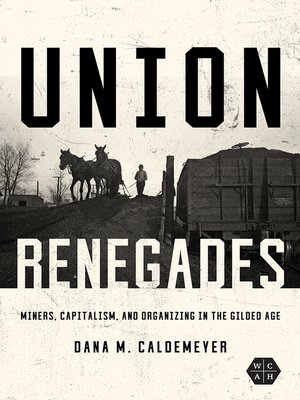Union Renegades
ebook ∣ Miners, Capitalism, and Organizing in the Gilded Age · Working Class in American History
By Dana M. Caldemeyer

Sign up to save your library
With an OverDrive account, you can save your favorite libraries for at-a-glance information about availability. Find out more about OverDrive accounts.
Find this title in Libby, the library reading app by OverDrive.



Search for a digital library with this title
Title found at these libraries:
| Library Name | Distance |
|---|---|
| Loading... |
In the late nineteenth century, Midwestern miners often had to decide if joining a union was in their interest. Arguing that these workers were neither pro-union nor anti-union, Dana M. Caldemeyer shows that they acted according to what they believed would benefit them and their families. As corporations moved to control coal markets and unions sought to centralize their organizations to check corporate control, workers were often caught between these institutions and sided with whichever one offered the best advantage in the moment. Workers chased profits while paying union dues, rejected national unions while forming local orders, and broke strikes while claiming to be union members. This pragmatic form of unionism differed from what union leaders expected of rank-and-file members, but for many workers the choice to follow or reject union orders was a path to better pay, stability, and independence in an otherwise unstable age.
Introduction
1 Deceived: Producers in a Dishonest World
2 Undermined: Winter Diggers, Union Strikebreakers
3 "Judases": Union "Betrayal" and the Aborted 1891 Strike
4 Outsiders: Race and the Exclusive Politics of an Inclusive Union, 1892-1894
5 Unsettled: Non-Union Mobilization and the 1894 Strike
6 Wolves: Fractured Unions in the Gilded Age, 1894-1896
Epilogue
Notes
Bibliography
Index|"Skillfully arranged. . . Caldemeyer demonstrates that the world of the Gilded Age working class was not as cut and dried as some of its would-be leadership thought it was — and that it was not as politically bespoke for as believed by many of the historians who have tried to interpret it." —Journal of American History
"Overall, Union Renegades offers an engaging account of Midwestern history, which will appeal to lay readers and provide scholars with innovative interpretations of labor history." —Choice
"Dana M. Caldemeyer's Union Renegades begins with a resonating bang for its reader. . . . A clear and thoughtful reexamination of labor struggles during the Gilded Age. Through six detailed and nuanced instances of dissatisfaction with the union, the book shows that miners navigated a complex world of capitalism and labor as individuals pursuing the best option for themselves as wage workers and miners." —Journal of the Illinois State Historical Society
|Dana M. Caldemeyer is an assistant professor of history at South Georgia State College.
Nuanced and eye-opening, Union Renegades challenges popular notions of workers attitudes during the Gilded Age.
|AcknowledgmentsIntroduction
1 Deceived: Producers in a Dishonest World
2 Undermined: Winter Diggers, Union Strikebreakers
3 "Judases": Union "Betrayal" and the Aborted 1891 Strike
4 Outsiders: Race and the Exclusive Politics of an Inclusive Union, 1892-1894
5 Unsettled: Non-Union Mobilization and the 1894 Strike
6 Wolves: Fractured Unions in the Gilded Age, 1894-1896
Epilogue
Notes
Bibliography
Index|"Skillfully arranged. . . Caldemeyer demonstrates that the world of the Gilded Age working class was not as cut and dried as some of its would-be leadership thought it was — and that it was not as politically bespoke for as believed by many of the historians who have tried to interpret it." —Journal of American History
"Overall, Union Renegades offers an engaging account of Midwestern history, which will appeal to lay readers and provide scholars with innovative interpretations of labor history." —Choice
"Dana M. Caldemeyer's Union Renegades begins with a resonating bang for its reader. . . . A clear and thoughtful reexamination of labor struggles during the Gilded Age. Through six detailed and nuanced instances of dissatisfaction with the union, the book shows that miners navigated a complex world of capitalism and labor as individuals pursuing the best option for themselves as wage workers and miners." —Journal of the Illinois State Historical Society
|Dana M. Caldemeyer is an assistant professor of history at South Georgia State College.







